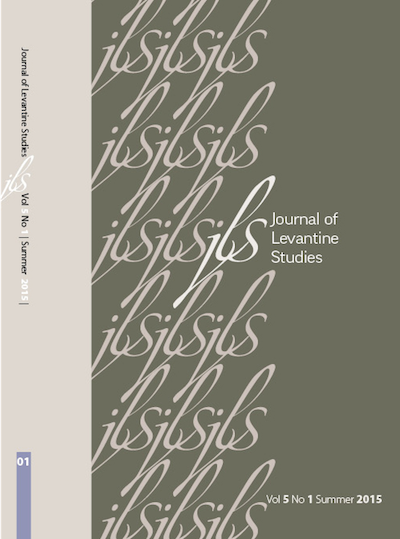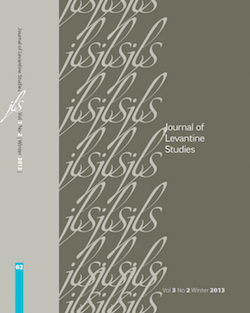-
Subscribe NowQuick view
Small Institution: Print + Online Subscription
$220.00 for 1 yearSubscribe NowQuick view -
Add to cartQuick view
The Challenge of Administering Justice to an Islamic Minority living in a Non-Muslim State: the Shari‘a Courts in Israel
Free!Iyad Zahalka
Add to cartQuick view -
Add to cartQuick view
The City Square in the Performance of Taanit: From Rabbinic Space to Contemporary Jerusalem
Free!In winter 2012 the Israeli group Tnua Tsiburit (Public Movement) initiated Taanit (Civil Fast), a performance action that first took place at Davidka Square, in Jerusalem. Taanit was designed to explore the potential role of the body, and of bodily self-affliction, in social and political protest. An intertextual analysis of Taanit reveals it also as a site-specific interpretation of the city square that examines its political-theological significance by evoking traditional, religious layers of meaning given to that place. Following the reclaiming of the city square that characterized recent protests around the globe, Public Movement’s civil fast reactivates the religious underpinnings of modern urban space by juxtaposing it with rabbinic traditions, illuminating through performance the potential significance that the rabbinic space of public fasting has for modern urban politics.
Add to cartQuick view -
 Add to cartQuick view
Add to cartQuick viewThe Khawaja
Free!Add to cartQuick view -
Add to cartQuick view
The Meaning of “Tolerance,” Which Is the Basis of Modern Civilization
Free!The following translation is a selection from the debate that occurred in 1902 and 1903 between Muhammad ʿAbdu (1849–1905) and Farah Antun (1874–1922), an Ottoman Orthodox Christian intellectual who emigrated from Tripoli to Egypt. The translated section focuses on the question of tolerance and illustrates both the advent of the liberal concept of tolerance in the Arab-Ottoman intellectual sphere and the reception of its ideational content.
Add to cartQuick view -
 Add to cartQuick view
Add to cartQuick viewThe Political Syntax of the Absentees: A Translator’s Reflection on Stella Maris
Free!Stella Maris, by Elias Khoury, is the follow-up novel to My Name Is Adam: Children of the Ghetto, Volume I, but the two novels can be read out of sequence, since they do not follow a linear narrative. Each is made up of multiple layers of space and time, entwined with the history and biography of Adam Danoun, as they move in a time machine-like fashion between past and future, and parallel worlds.
Add to cartQuick view -
 Add to cartQuick view
Add to cartQuick viewThe Prophet Nahum’s Prophecy of Doom to His Manservant Mordekhai-Hai in the Year 1941
Free!Add to cartQuick view -
Add to cartQuick view
The Rear Side of the Front: Gaza and Its People in World War I
Free!During the First World War, the city of Gaza, a regional hub of forty thousand souls and a major market and exporter of grains, turned into a battlefield. While the military and political consequences of this arena are well researched, this article examines its civil and social aspects as well, in order to better understand the story of the First World War in Palestine. Using both British and Ottoman documentation alongside civil accounts and memoirs, the article discusses the reasons, methods, and effects of the city’s complete evacuation and the massive destruction of its physical environment. The civil perspective of the war reflected in the fate of Gaza poses a challenge to common chronological and spatial presumptions about the war itself, and it allows a rethinking of the Mandate period in the light of postwar circumstances.
Add to cartQuick view -
 Add to cartQuick view
Add to cartQuick viewThirst
Free!Add to cartQuick view -
 Add to cartQuick view
Add to cartQuick viewThis Is al-Lydd/This Is Palestine
Free!I delivered this talk at a meeting organized by youth groups in the city of al-Lydd and held at the Communist Party’s club on Friday night, July 13, 2018, on the seventieth anniversary of the occupation of al-Lydd, and one of the biggest massacres of the 1948 Nakba War, and the expulsion of the overwhelming majority of its residents, and the internment of those who remained in a ghetto enclosed by a barbed wire fence.
Add to cartQuick view -
 Add to cartQuick view
Add to cartQuick viewTraveling Global Objects
Free!Add to cartQuick view
- Home
- About JLS
- Issues
- Vol. 9 No. 1 | Summer 2019
- Vol 8 No 2 Winter 2018
- Vol. 8, No. 1: Summer 2018
- Vol. 7, No. 2: Winter 2017
- Vol. 7, 1: Summer 2017
- Vol. 6, Summer/Winter 2016
- Vol. 5, No. 2 Winter 2015
- Vol. 5, No. 1 Summer 2015
- Vol. 4, No. 2 Winter 2014
- Vol. 4, No. 1 Summer 2014
- Vol. 3, No. 2 Winter 2013
- Vol. 3, No. 1 Summer 2013
- Vol. 2, No. 2 Winter 2012
- Vol. 2, No. 1 Summer 2012
- Vol. 1, No. 2 Winter 2011
- Vol. 1, No. 1 Summer 2011
- Blog
- dock-uments
- Subscribe
- Submit
- Contact




